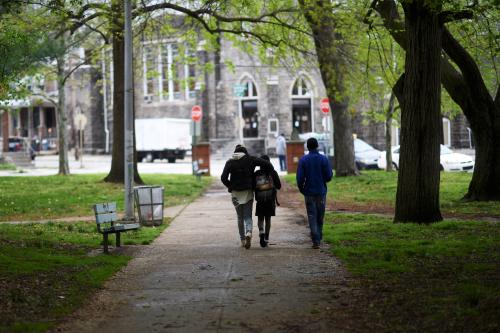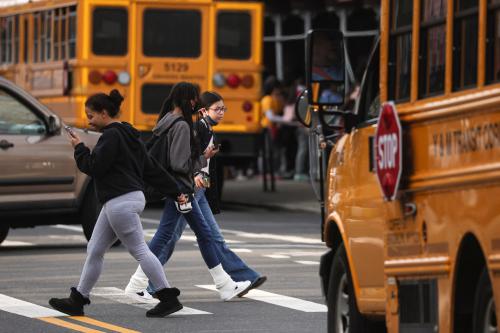With President Trump’s recent attacks on the California homeless population and talk of a related policy “crackdown,” this is a good time to consider the opportunities and resources available to homeless students in America. More than a million U.S. students meet the federal definition of homeless. It’s a group with complex, varied, and extensive needs—many of which go unmet—and outcomes that lag well behind those of the rest of the student population.
This post examines federal funding for homeless students. Among the federal government’s primary roles in K-12 schooling is the protection and promotion of educational opportunities for disadvantaged students, in part through compensatory funding. We argue that current funding is both insufficient and inefficiently allocated, but there is reason for optimism for the years ahead.
The homeless student population in the U.S.
The homeless student population has climbed in recent years, both in overall numbers and the share of the U.S. public school population. The National Center for Homeless Education (NCHE) estimates that about 1.36 million public school students experienced homelessness during the 2016-17 school year. That’s nearly 3% of the student population, a share that has roughly doubled over the last decade (perhaps in part because of better identification practices). Figure 1, below, displays this trend.
At first glance, federal estimates of the homeless student population seem inconsistent with estimates of the broader U.S. homeless population (roughly 550,000 Americans on a given night). The reason is the relatively inclusive definition of student homelessness. In particular, “doubled-up” students who share the housing of others because of economic adversity, home loss, domestic violence, or other hardships meet the federal definition of homeless. Doubled-up students account for about three-quarters of the country’s homeless student population.
Some criticize this definition. For example, in response to Sen. Joe Manchin’s (D-W.Va.) recent call for more federal resources for homeless students, the Republican president of the West Virginia state Senate, Mitch Carmichael, argued that identifying doubled-up students as homeless obscures the problem and serves to “minimize the terrible dilemma that truly homeless children face.”
We found little information available on the academic outcomes of doubled-up homeless students relative to other homeless students (e.g., students living in cars, parks, public spaces, motels, or transitional shelters). In response, we asked the Louisiana Department of Education—a helpful research partner on this post—for its most recent state assessment data, disaggregated by students’ poverty status and living situations.
The data make it plain that doubled-up students face serious challenges. Figure 2 displays 2019 results from Louisiana’s state assessments in math and English language arts (ELA), combined for grades three through eight.
The academic outcomes for doubled-up homeless students and other homeless students are almost indistinguishable from one another—and well below the outcomes for Louisiana’s economically disadvantaged student population. For example, 18% of doubled-up students scored “mastery” or better in math, compared to 17% of other homeless students. A slightly lower percentage of doubled-up students (24%) than other homeless students (26%) scored “mastery” or better in ELA. These results are broadly consistent with published results from the state of Washington.
Homeless students’ needs vary considerably from student to student, and it’s likely that doubled-up students tend to have different needs from other homeless students. Still, the notion that doubled-up students are not truly vulnerable—for example, that they simply have close extended families—is not supported by evidence. It is a highly disadvantaged student population that very likely would benefit from additional resources and support.
Federal funding for homeless students
The federal government funds an assortment of services intended to prevent and reduce youth homelessness, and to attend to the needs of the homeless. The most direct source of educational support funding is the Education for Homeless Children and Youth (EHCY) program, which is authorized under the McKinney-Vento Homeless Assistance Act.
EHCY funds must be used for homeless students but are relatively flexible in their specific uses. For example, they can provide transportation for students whose change of residence makes it difficult or expensive to get to school, along with paying for mentoring and counseling, uniforms, tutoring, school supplies, and extracurricular activities. The Washington Post recently profiled the District of Columbia’s efforts to support its homeless students’ college transition.
EHCY funding has increased in recent years, with appropriations of $93.5 million for fiscal year 2019. Still, funding levels remain low on a per-pupil basis, as the number of identified homeless students has increased along with the funding. As displayed in Figure 3, EHCY funding currently amounts to about $54 per homeless student. (The spike in 2008-09 funding reflects a one-time influx in funding from the American Reinvestment and Recovery Act.)
Along with being extremely modest, McKinney-Vento funds are distributed unevenly across states. Funds are allocated to states according to each state’s proportion of the country’s ESEA Title I, Part A funding, which is determined largely by estimates of the number of children in low-income families. However, the correlation between states’ student homelessness rates and free/reduced-price lunch rates is lower than one might expect (about 0.48 by our calculations). This could reflect true discrepancies in states’ student populations, differences across states in how accurately they identify students, or a combination of the two.
A consequence of these differences is that per-homeless-student EHCY funds vary sharply across states. For example, based on expenditures and homeless student counts in 2016-17, we estimate that per-pupil EHCY funds ranged from $27 in Washington to $214 in Rhode Island. Figure 4 illustrates the variation.
While it’s possible that the needs of homeless students vary across states, there is no reason to believe that this state-to-state variation reflects those needs. Moreover, using Title I, Part A allocations rather than state-level homeless counts as the basis of McKinney-Vento allocations could represent a missed opportunity to incentivize states and districts to more accurately identify their homeless student populations.
Opportunities ahead
While current funding levels seem jarringly low on a per-homeless-student basis (along with being inefficiently allocated), there are reasons for optimism. For one, several Democratic presidential candidates—including Elizabeth Warren, Joe Biden, Bernie Sanders, Kamala Harris, and Pete Buttigieg—have talked about tripling, quadrupling, or massively increasing Title I, Part A funding (currently around $16 billion annually). Even an increase in McKinney-Vento funding that takes every state to Rhode Island’s per-homeless-student funding level ($214) would amount to less than 1% of the funding required to triple Title I funding. Moreover, beyond the presidential campaign, federal policymakers from both sides of the aisle are expressing interest in issues such as student homelessness and foster care. McKinney-Vento has long benefited from bipartisan support.
Few groups of students have needs as severe, complex, and resource-intensive as homeless students. The federal government has played an important, if inadequate, role in addressing those needs via the supplemental funding it provides to states. It could choose to fulfill that role more effectively in the years ahead.
The authors would like to thank the Louisiana Department of Education and the National Center for Homeless Education for their help with this post.








Commentary
Better serving the needs of America’s homeless students
October 24, 2019